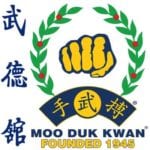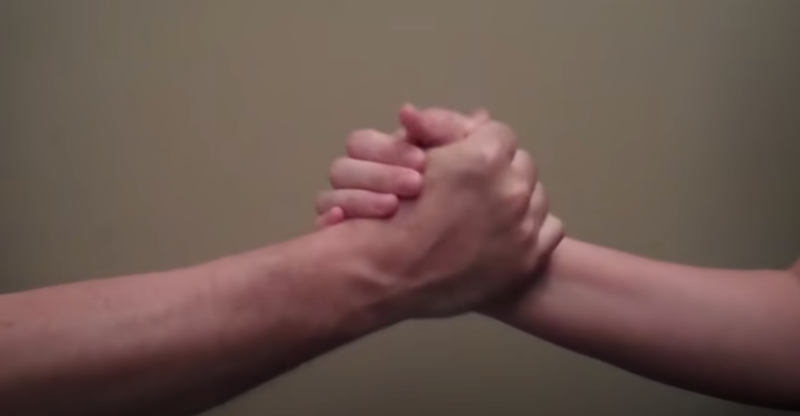Does The Moo Duk Kwan® Have A Secret Handshake?
 Does the Moo Duk Kwan® have a secret handshake like some of fraternities, clubs, secret societies,etc.?
Does the Moo Duk Kwan® have a secret handshake like some of fraternities, clubs, secret societies,etc.?
"A secret handshake is a distinct form of handshake or greeting which conveys membership in or loyalty to a club, clique or subculture and friends.
--Wikipedia"

This is NOT the Moo Duk Kwan secret handshake.
Merely asking this question about any group or organization instantly reveals that the asker is not a member of the group they are inquiring about or they would not need to ask.
Members of a group with a secret handshake already know one exists and need not ask.
However, since you expended some effort to gain access to this article, that means the click-bait title worked. 🙂
So here ya go...
If you are already in the Moo Duk Kwan®, then most of this is well known to you, so bear with me to the closing summation.
The Moo Duk Kwan® organization's culture is informed by, and infused with, South Korean cultural aspects and is dedicated to the preservation, thereof. So too, is the United States Moo Duk Kwan Federation®.
Regardless of the country in which Moo Duk Kwan® members reside, Korean cultural practices are preserved as part of the mission of the Moo Duk Kwan and 2020 marks 75 years of dedicated preservation by members and supporters worldwide.
To answer the question, consider that a "handshake" is one form of greeting. There are many common greeting traditions around the world other than a literal "handshake," but they serve the same purpose which is to appropriately greet another in their respective culture.
Some of the following excerpts are from eDiplomat.com, although many are well known to Moo Duk Kwan members as a result of their training and education in the Moo Duk Kwan.
In South Korea, greeting and meeting traditions include:
- The bow is the traditional Korean greeting, although it is often accompanied by a handshake among men. To show respect when shaking hands, support your right forearm with your left hand.
- Korean women usually nod slightly and will not shake hands with Western men. Western women may offer their hand to a Korean man.
- Bow when departing. Younger people wave (move their arm from side to side).
Additionally, in Korean culture when greeting each other names and titles are very important.
- It is considered very impolite to address a Korean with his or her given name. Address Koreans using appropriate professional titles until specifically invited by your host or colleagues to use their given names.
- Americans should address a Korean with Mr., Mrs., Miss + family name; however, never address a high-ranking person or superior in this manner.
- Korean names are the opposite of Western names with the family name first, followed by the two-part given name. The first of the two given names is shared by everyone of the same generation in the family, and the second is the individual's given name. Example: Lee (Family) + Dong (Shared Given) + Sung (Given). Dong Sung is the individual's given name. Address him as Mr. Lee or Lee Sonsaengnim (which means "teacher").
Body language is yet another attribute of greetings and interactions that must be properly incorporated in Korean culture.
- Koreans consider it a personal violation to be touched by someone who is not a relative or close friend. Avoid touching, patting or back slapping a Korean.
- Direct eye contact between junior and senior businesspeople should be avoided. This is seen as impolite or even as a challenge.
- Do not cross your legs or stretch your legs out straight in front of you. Keep your feet on the floor, never on a desk or chair.
- Always pass and receive objects with your right hand (supported by the left hand at the wrist or forearm) or with two hands.
- To beckon someone, extend your arm, palm down, and move your fingers in a scratching motion. Never point with your index finger.
Now consider the additional attributes that the general public may have little to no knowledge about, but which a Moo Duk Kwan member must know and evaluate in order to properly greet a fellow Moo Duk Kwan member.
- 1st, is the other person a Moo Duk Kwan member? How do you tell?
- If wearing street clothes, are they displaying the Moo Duk Kwan fist logo on or about their person in some fashion?
- If so, is it a legitimate, authorized depiction of the fist logo or a counterfeit?
- If in uniform, are they wearing a dobahk that is properly trimmed for the Moo Duk Kwan?
- improperly trimmed dobahks, unauthorized patches, etc., are clues that a Moo Duk Kwan member will consider instantly
- Are they wearing a legitimate Moo Duk Kwan belt on their dobahk?
- nonstandardized belts, extra stripes, different colors, etc.,are clues that a Moo Duk Kwan member will consider instantly
- If wearing street clothes, are they displaying the Moo Duk Kwan fist logo on or about their person in some fashion?
- 2nd, if the other person passes the 1st level visual observations, then a Moo Duk Kwan member needs to know how to properly greet them.
- Is the other person older or younger than you?
- Is the other person higher or lower rank than you?
- Does the other person have a special salutation that should be used?
- Does the other person have a role or position that should be acknowledged when greeting them?
- 3rd, based on all these observations, cultural nuances, and Moo Duk Kwan specifics, can you construct the proper greeting?
- Do you know that touching is not common in Korean culture?
- Do you know the proper body language to employ when greeting another?
- Do you know acceptable differences in the way seniors and juniors may greet or interact with one another?
- Do you know the other person well enough to know their proper salutation?
- Do you know how age affects the use of "nim" in the salutation that may be part of a greeting?
- Do you know the other person's role or position in the Moo Duk Kwan and if it should be incorporated when greeting them?
- Do you know how to combine all these factors into the appropriate greeting?
Even long-time Moo Duk Kwan members may sometimes struggle with deriving the "secret handshake" from all these factors due to the obfuscated nature of some information that must be known to construct the proper greeting for another Moo Duk Kwan member.
After all, the only way you might know some of these things is if you are interacting with the other person on a frequent basis in a Moo Duk Kwan context.
Making the proper Moo Duk Kwan greeting even more secretive is the fact that each person's rank, salutation, roles and positions may change at any time unbeknownst to the other... unless both parties are interacting frequently as fellow Moo Duk Kwan members.
For example, do you notice when someone greets you with the wrong salutation in email, on social media, on the phone or in person? Sure you do. Immediately.
In person, the complete Moo Duk Kwan "secret handshake" a.k.a proper greeting also involves the entire body, proper language, appropriate behavior, and some intimate knowledge about the person in the Moo Duk Kwan that only a fellow Moo Duk Kwan member is likely to know.
So how do you know the proper greeting a.k.a the Moo Duk Kwan "secret handshake" to use with a legitimate fellow Moo Duk Kwan member?
You will either know it because you are a fellow Moo Duk Kwan member, or you will not know it.
This is the way.
Shout out to Mandalorian fans 🙂
The Moo Duk Kwan "secret handshake" a.k.a. proper greeting is also dynamic and may change at any time, so only fellow Moo Duk Kwan members are likely to know it.
Interested readers can witness the Moo Duk Kwan secret handshake among members during the upcoming 1st Moo Duk Kwan National USA Virtual Competition October 17,2020 and the 75th Moo Duk Kwan Virtual Celebration Nov 6-9, 2020.
I observe that the Moo Duk Kwan "secret handshake" a.k.a. proper greeting between Moo Duk Kwan members is far more complex and takes far longer to learn than any other secret handshake routine on YouTube.... and... AND it is a work of art when performed correctly. 🙂
And there you have the Moo Duk Kwan "secret handshake."
Can you do it?